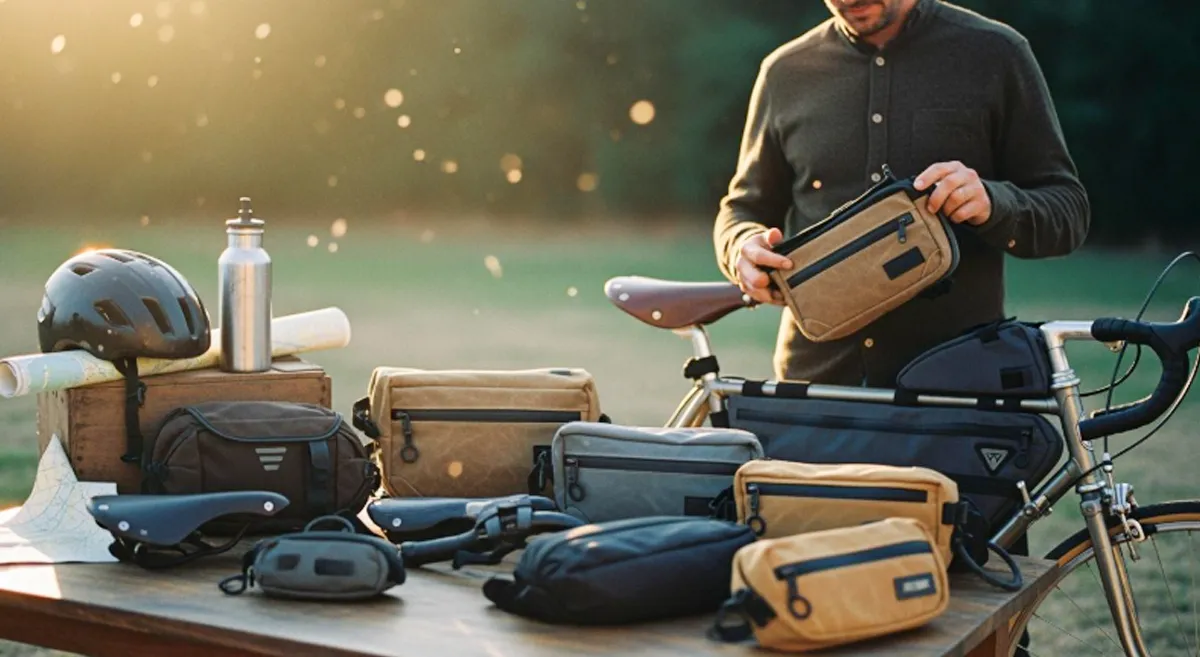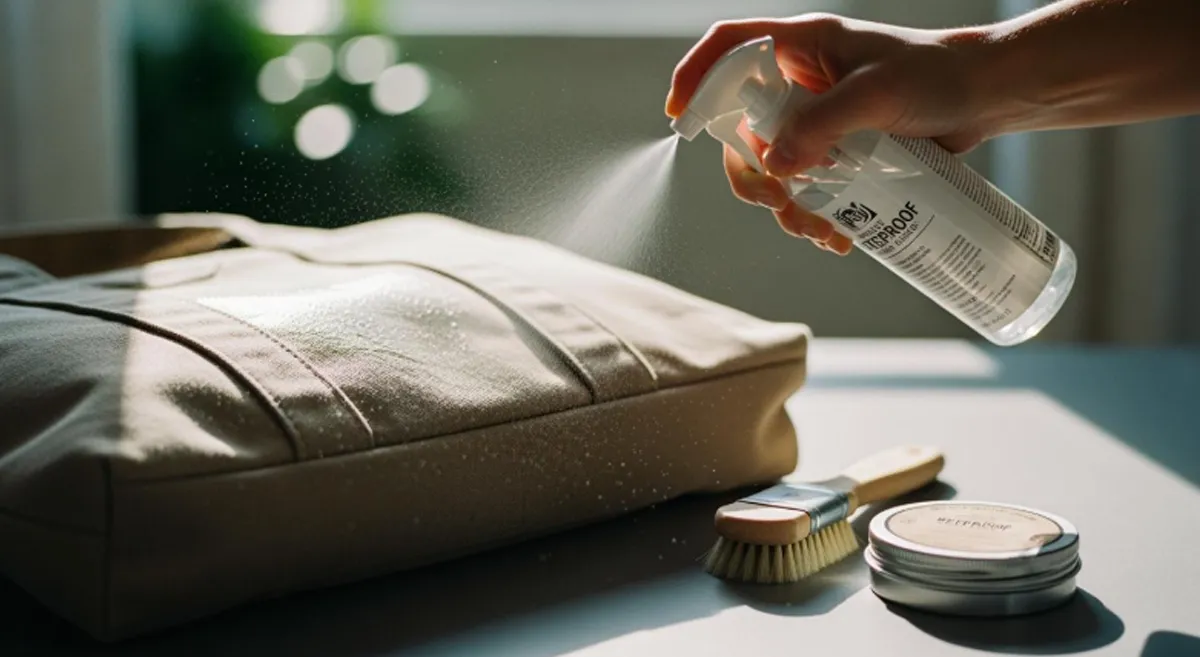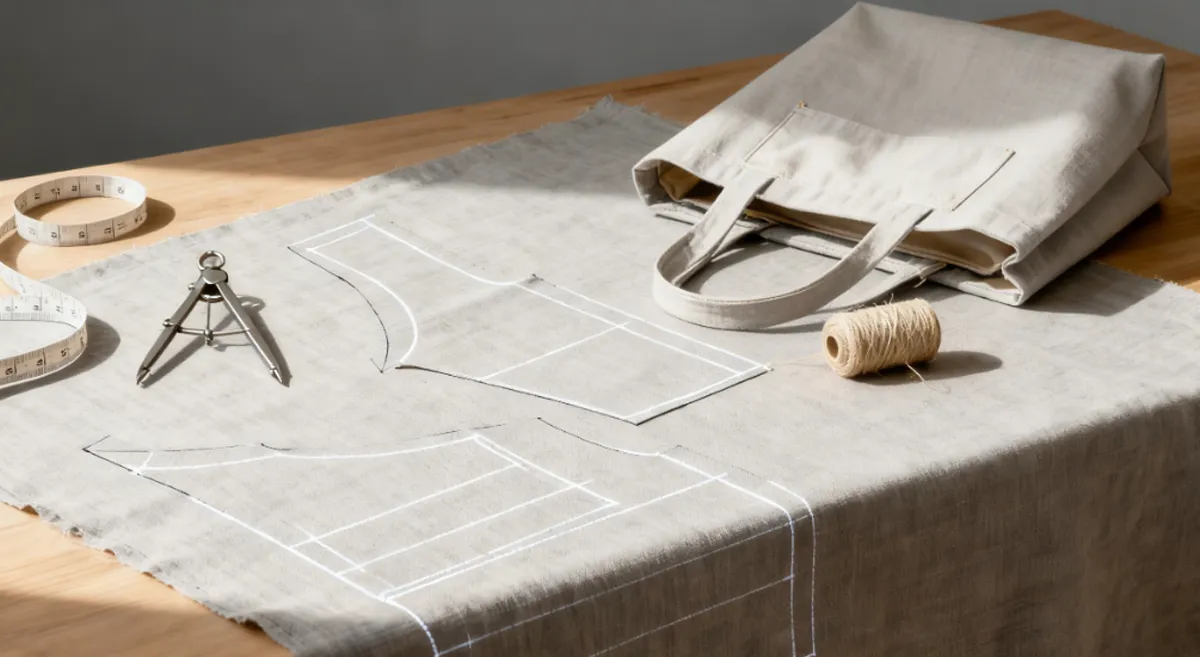Ever think about what size backpacks you need for school or trips? Most daypacks can hold about 22 liters. This size fits books, snacks, and a water bottle. If you go on a longer trip, you need a bigger pack. Multi-day packs hold about 55 liters. These packs have space for clothes and gear. Look at this table to see common backpack sizes:
| Type of Backpack | Average Volume (L) | Median Volume (L) |
|---|---|---|
| Daypacks | 22.4 | 22 |
| Multi-Day Packs | 51.9 | 55 |
You may wonder what size backpacks work for school, travel, or hiking. INITI is a company that makes backpacks. They let you pick a bag for any activity. Think about what size backpacks fit your body and feel comfortable. You can also choose eco-friendly options. The best size backpack depends on what you need most, so consider what size are backpacks that will suit your specific requirements.
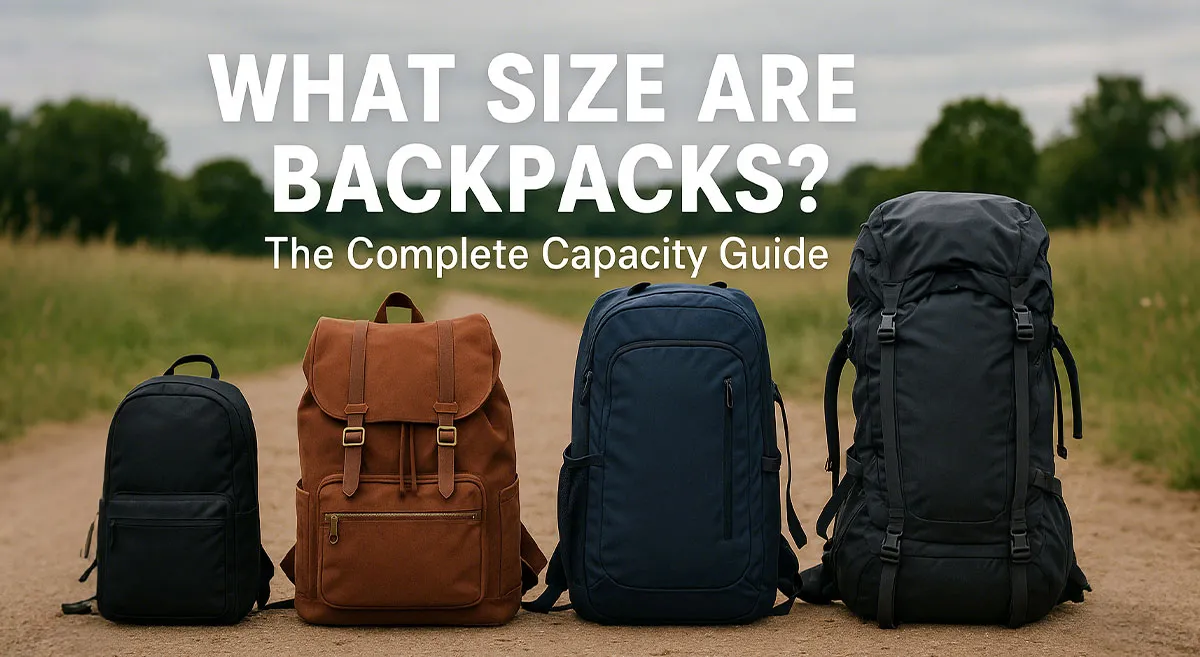
Key Takeaways
- Most daypacks can hold about 22 liters. This size works well for school supplies and snacks.
- For longer trips, you should use multi-day packs. These usually hold 55 liters or more.
- Pick a backpack size based on what you will do. Small (10-19L) is good for kids. Medium (20-29L) works for school. Large (30-39L) is best for weekend trips. Extra large (40L+) is great for hiking.
- Comfort matters most. Look for padded straps and a good fit. This helps you avoid back pain.
- INITI lets you customize backpacks. You can pick the size, material, and features you want.
- When you choose a school backpack, look for 25-35 liters. This size fits books and a laptop well.
- For travel, make sure your backpack fits airline carry-on rules. These are usually around 20-40 liters.
- Eco-friendly backpacks use recycled materials. These help you and the environment.
Standard Backpack Size & Dimensions
When you look for the correct standard backpack size, you want something that fits your needs and feels comfortable. You might wonder what the common dimensions of standard backpacks are. Let’s break it down so you can pick the best backpack sizes for school, travel, or outdoor adventures.
Backpack Size Chart
You can use a backpack size chart to compare popular backpack sizes. This chart helps you see which volume works for your activity. Here’s a simple guide:
| Size | Volume (Liters) | Typical Use Case |
|---|---|---|
| Small | 10–19L | Kids’ bag, daily carry, hydration pack |
| Medium | 20–29L | School, daypack, carry-on travel |
| Large | 30–39L | Weekend trips, big school pack |
| Extra Large | 40L+ | Hiking, camping, extended travel |
Small (10–19L)
Small backpacks are perfect for quick trips or everyday use. You can fit snacks, a phone, and maybe a light jacket. Many kids use small backpacks for school or sports. If you want something lightweight, small is the way to go. INITI offers compact 10L daily bags that are easy to carry and simple to customize.
Medium (20–29L)
Medium backpacks give you more space for books, a laptop, and lunch. Most school bags fall into this range. You can use medium backpacks for day trips or as a carry-on when you travel. INITI’s mid-size 20–30L bags work well for students and professionals. You can pick the color, material, and even add your logo.
Large (30–39L)
Large backpacks are great for weekend trips or carrying lots of gear. You can pack clothes, shoes, and even a camera. Many travelers and older students choose large backpacks for extra room. INITI’s large backpacks offer strong straps and extra compartments. You can adjust the design to fit your brand or team.
Extra Large (40L+)
If you need to carry gear for hiking or camping, extra large backpacks are your best choice. You get plenty of space for sleeping bags, food, and water. INITI’s large 40L+ hiking bags are built for outdoor adventures. You can customize the pockets, straps, and choose eco-friendly materials.
INITI Backpack Materials
You want your backpack to last and look good. INITI uses strong materials like polyester, nylon, canvas, and RPET. RPET is made from recycled plastic bottles, so it’s eco-friendly. You can choose waterproof fabrics for rainy days or pick soft cotton for comfort. INITI lets you design your own backpack, from the fabric to the color and even the logo. You can ask for extra padding, special compartments, or unique shapes. If you care about the environment, INITI offers sustainable options for every backpack size.
Tip: If you want a custom backpack for your business or school, INITI can help you pick the right material and size. You design it, INITI makes it.
Measuring Backpack Volume
You might wonder how companies measure backpack volume. The standard way uses small spheres to fill the bag and count the space inside. The ASTM F2153-07(2018) method uses 20-mm spheres, but some brands use beans or other fillers. This can change the numbers you see online. Most standard backpack size measurements fall between 20–30 liters, with heights around 18–20 inches, widths of 12–14 inches, and depths of 6–8 inches. These backpack dimensions work for school, travel, and daily use.
If you want the correct standard backpack size for your needs, check the volume and the backpack dimensions. INITI supports custom sizing, so you can get small, medium, or large backpacks that match your brand or activity. You can even ask for special shapes or extra pockets.
Here’s a quick look at the common dimensions of standard backpacks:
| Dimension | Metric | Imperial | Notes |
|---|---|---|---|
| Height | 45–50 cm | 18–20 in | Fits most torsos, includes top handle |
| Width | 30–35 cm | 12–14 in | Fits laptops up to 15″ |
| Depth | 15–20 cm | 6–8 in | Slim for easy carrying |
You can see that medium backpacks and large backpacks fit most school and travel needs. Small backpacks work for kids or light daily use. If you want something bigger, extra large backpacks are perfect for hiking or long trips.
Note: INITI lets you choose the correct standard backpack size for your business, school, or outdoor event. You can pick the volume, the backpack dimensions, and the material. INITI’s team helps you design a backpack that fits your style and purpose.
What Size Are Backpacks for School
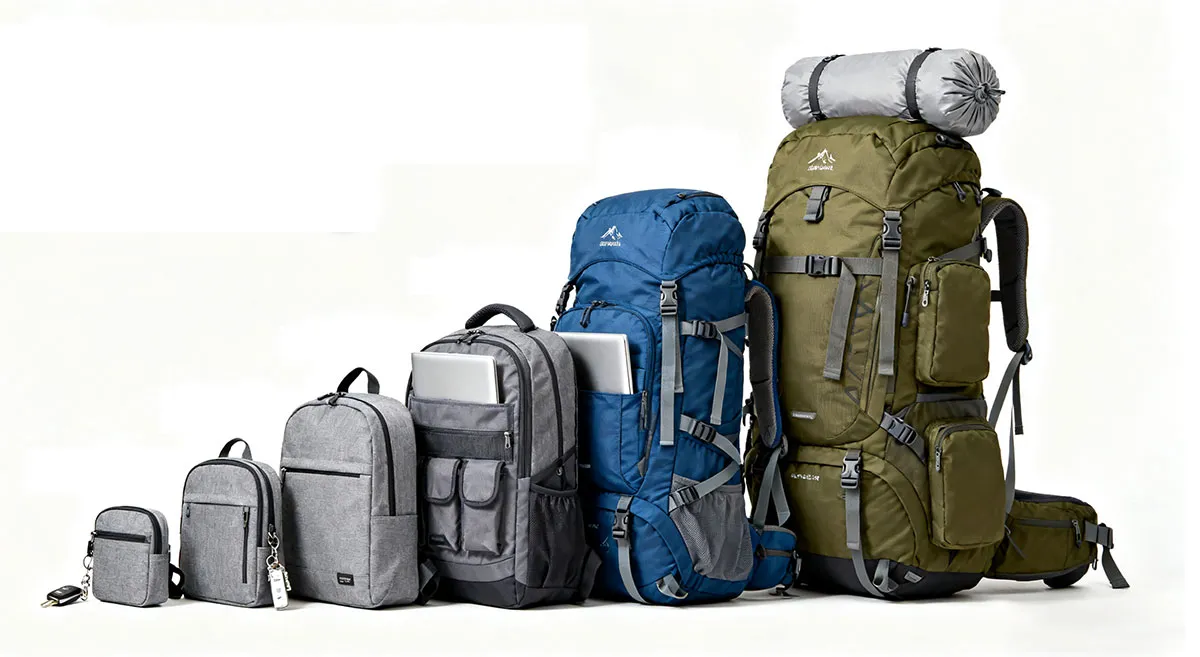
School Backpack Volume
Picking the right backpack for school can make your day easier. You want a bag that fits your books, lunch, and maybe a laptop. Most experts say school backpacks should hold between 25 and 35 liters. This size gives you enough space for everything without making the bag too heavy. If you’re in middle or high school, you might need a bigger backpack for extra books or sports gear.
Here’s a quick look at how backpack volume matches your age and grade:
| Child’s age | Backpack volume | Maximum load |
|---|---|---|
| up to 2 | 3 – 5 liters | 0.5 kg |
| 2 – 3 | 4 – 6 liters | 1 kg |
| 3 – 4 | 6 – 9 liters | 1.5 kg |
| 5 – 6 | 10 – 12 liters | 2 kg |
| 6 – 8 | 15 – 18 liters | 3 kg |
| 8 – 10 | 16 – 20 liters | 5 kg |
| 10 – 12 | 18 – 24 liters | 6 kg |
| 12 – 16 | 20 – 28 liters | 7 kg |
| Over 16 | 25 liters + | 10 kg + |
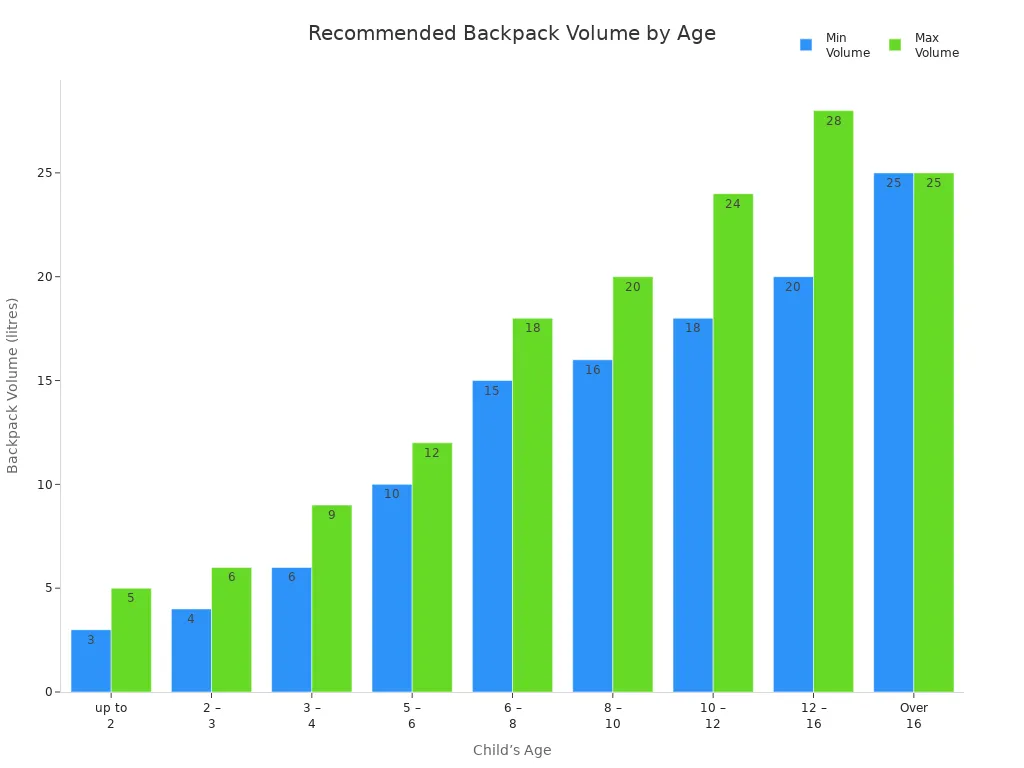
You can see that as you get older, you need a bigger backpack. If you’re in high school, a 35-liter backpack works well for carrying textbooks, gym clothes, and tech.
Tip: Try not to fill your backpack with more than 10 percent of your body weight. This keeps your back safe and helps you feel comfortable all day.
INITI School Backpack Features
INITI designs school backpacks with students in mind. You get padded straps that make carrying heavy books easier. The bags have special compartments for laptops, water bottles, and lunch boxes. You can choose a backpack with extra pockets for pens, keys, and chargers. INITI lets you pick the color, material, and even add your school logo.
Here are some features you might like:
- Padded shoulder straps and back panels for comfort
- Adjustable straps to fit your body
- Multiple compartments for easy organization
- Water-resistant materials to protect your stuff
- Eco-friendly options like RPET fabric
If you want a custom backpack for your school, INITI helps you design it. You can choose the size, shape, and features that work best for you and your classmates.
Age & Grade Considerations
Your age and grade matter when you pick a backpack. Younger kids need smaller bags. Older students need more space for books and gear. Here’s a table to help you match backpack size to your grade:
| Age Group | Recommended Length | Recommended Width | Recommended Depth | Weight Limit | Recommended Capacity |
|---|---|---|---|---|---|
| Preschoolers | 16-18 inches | 13-15 inches | 2-4 inches | Up to 10% of body weight | Up to 15 liters |
| Elementary School | 17-19 inches | Up to 15 inches | 4-6 inches | Up to 15% of body weight | Up to 20 liters |
| Middle School | 18-20 inches | 16 inches | Up to 8 inches | Up to 20% of body weight | 25-35 liters |
| High School | 19-21 inches | N/A | N/A | Up to 25% of body weight | 35 liters and above |
When you shop for a backpack, measure your back from your neck to your hips. Make sure the bag sits two inches below your shoulder blades and ends at your waist. Look for padded straps and a padded back. These features help balance the load and keep you comfortable.
Note: INITI’s school backpacks come in all sizes. You can find the perfect fit for your age, grade, and daily needs. If you want something special, INITI can customize your backpack just for you.
Travel Backpack Size Guide
Carry-On Travel Backpack
When you fly, your backpack must fit airline rules. Most airlines let you bring a carry-on if it fits under the seat or in the overhead bin. If your bag is too big, you may need to check it. Here are size limits for carry-on travel backpacks from some airlines:
| Airline | Carry-On Maximum Dimensions |
|---|---|
| American Airlines | 22″ x 14″ x 9″ |
| Alaska Airlines | 22″ x 14″ x 9″ |
| Avelo Airlines | 22″ x 14″ x 9″ |
| Allegiant Air | 10″ x 16″ x 22″ |
Check your airline’s website before you pack your bag. Most carry-on travel backpacks hold about 20 to 40 liters. This size lets you pack clothes, shoes, and a laptop. You can move through airports easily with a backpack that fits these rules.
INITI makes travel backpacks that work well for carry-on use. You get smart features that make your trip easier:
| Feature | Description |
|---|---|
| Carry-on compatibility | Fits airline size limits, often with expandable space |
| Organization | Many pockets for valuables, electronics, and accessories |
| Laptop and Tablet Sleeves | Padded spots for laptops (up to 15 inches) and tablets |
| Water Bottle Pockets | Side pockets for bottles or hydration packs |
| Grab Handles | Handles on all sides for easy carrying |
| Alternate Carry Methods | Carry as a suitcase or over your shoulder |
| Lockable Zippers | Extra security for your things |
| Durability | Strong materials for frequent travel |
| Built-in Rain Covers | Some models have rain covers for wet weather |
| Pass-through Sleeves | Attach your backpack to rolling luggage |
Tip: Pick a travel backpack with padded straps and a soft back panel. You will feel better during long walks in airports.
Checked Travel Backpack
Sometimes you need more space for your trip. If you pack for a long vacation or bring extra gear, you might check your backpack. Checked travel backpacks usually hold between 28 and 40 liters. Here are some tips for picking the right size:
- Pick 28 liters if you pack light or travel for a short time.
- Choose 35 liters if you need more clothes or gear.
- Go up to 40 liters for longer trips or if you want the biggest size allowed for a travel pack.
- Many travelers use carry-ons around 40-45 liters, especially if they stay in hotels or hostels.
A checked backpack gives you more room, but you should still check airline rules for size and weight. INITI offers large travel backpacks that are strong and easy to carry. You can add extra pockets, padded straps, or even a rain cover.
Note: Always label your checked backpack with your name and contact info. This helps if your bag gets lost.
INITI Travel Backpack Customization
Every traveler has different needs. Maybe you want a backpack for business trips, or you need one for hiking adventures. INITI lets you design travel backpacks that fit your style and your trip. You can choose the fabric, size, and special features.
| Feature Category | Details |
|---|---|
| Fabric Characteristics | Durable, water-resistant, lightweight, and breathable materials |
| Function | Multi-functional pockets, security features, comfy straps |
| Size | Many sizes and expandable designs for all types of travel |
| Bag Accessories | USB ports, removable pouches, and more |
| Usage Scenarios | Great for adventure, business, or daily commuting |
| Consumer Groups | Perfect for travel lovers, students, and business travelers |
You can pick eco-friendly materials like RPET, which is made from recycled bottles. INITI helps you add your logo, choose colors, and create a backpack that matches your brand or personal taste. If you want a travel backpack that stands out and meets airline rules, INITI can make it happen.
Tip: Think about what you need most—organization, comfort, or style. INITI can help you design the perfect travel backpack for your next adventure.
Hiking Backpack Size
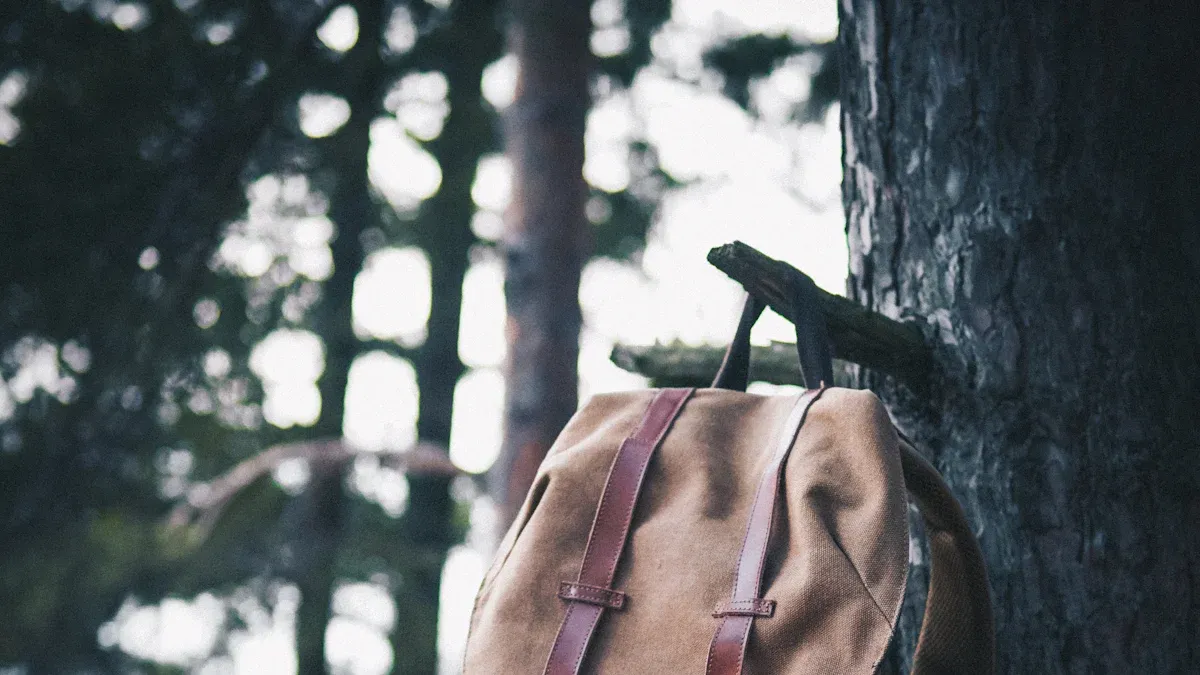
Choosing the right backpack for your next outdoor adventure can make your trip much more enjoyable. You want a pack that fits your gear, feels comfortable, and matches the length of your hike. Let’s break down the best sizes for day hikes and multi-day trips.
Daypack (20–30L)
If you plan a short hike or a day out on the trail, a daypack is your best friend. Most outdoor experts agree that a 20 to 30-liter backpack gives you enough space for water, snacks, a light jacket, and a first-aid kit. This size works well for average day hikes and even for everyday use.
Here’s a quick look at what different day hikes might need:
| Hiking Activity | Ideal Volume Range (liters) |
|---|---|
| Short day hikes | 10-20 |
| Summit packs | 18-24 |
| Average day hikes and everyday use | 20-30 |
| Long day hikes and ultralight overnights | 30-40 |
You can see that most hikers choose a backpack in the 20–30L range for day trips. This size keeps your load light but still gives you room for the basics.
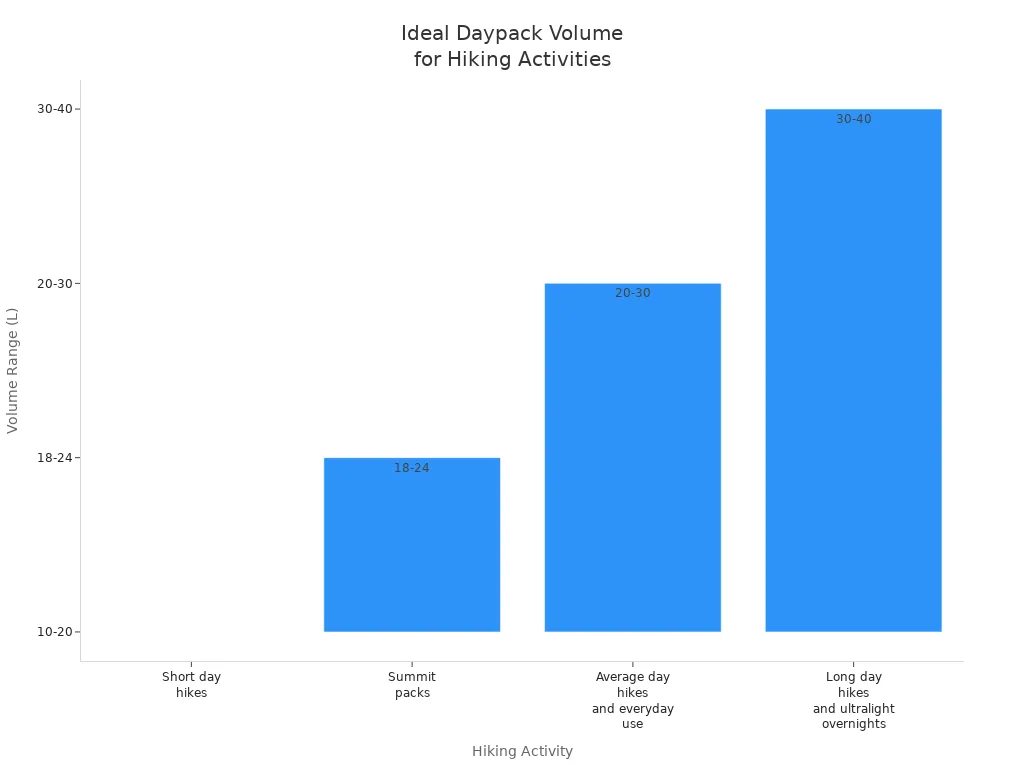
Tip: Pick a daypack with padded straps and a breathable back panel. You’ll feel more comfortable on the trail.
Multi-Day Pack (30–50L+)
Planning to camp overnight or hike for several days? You’ll need a bigger backpack. Multi-day packs usually hold between 30 and 50 liters, but some go even larger for longer trips or extra gear. This size lets you carry a sleeping bag, tent, food, and extra clothes.
Check out this table to see how backpack size matches different trip lengths:
| Backpack Size (L) | Weight (lbs) | Use Case |
|---|---|---|
| 65L or larger | 4-5+ | Family or gear-heavy trips (40-50 lbs of gear) |
| 50-65L | 3-4 | Longer trips (30-45 lbs of gear) |
| ~50L or smaller | <3 | Weekend or lightweight multi-day backpacking |
| 30-45L | 2.5-4 | Ultralight weekend trips or gear-heavy day trips |
| 20-30L | 1.5-2.5 | Day hikes (15-25 lbs of gear) |
| <20L | <1.5 | Trail runs or very light day hikes |
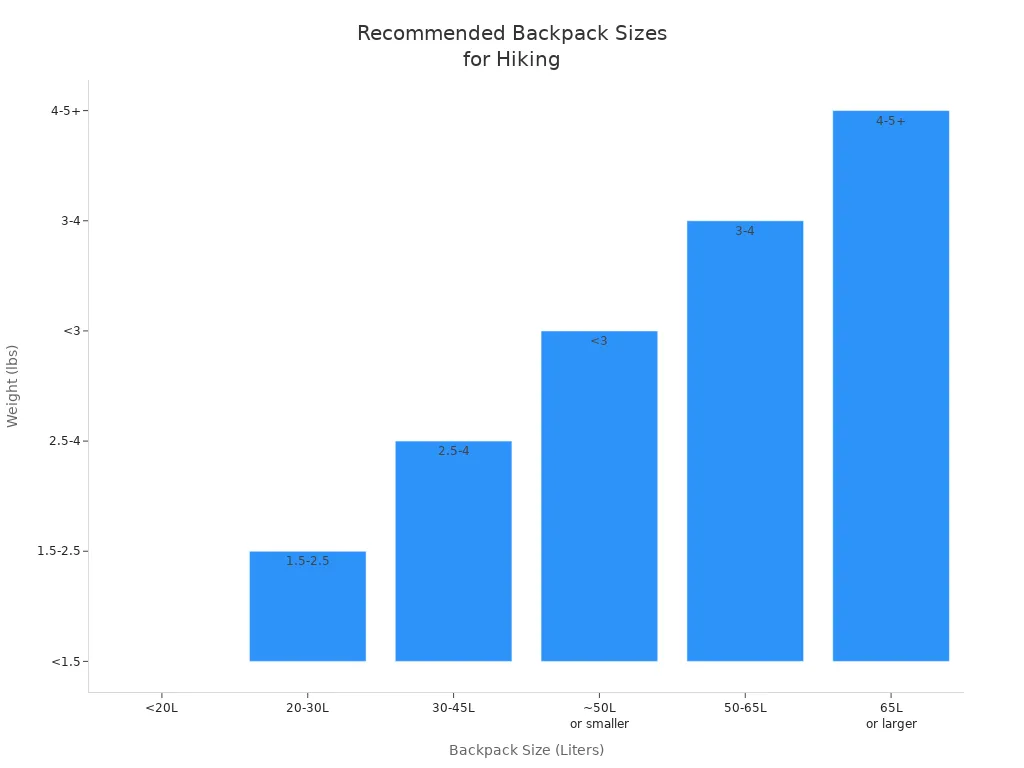
A 40-liter backpack is a popular choice for weekend adventures. If you need to carry more, like for a family trip, you might want a 65-liter pack.
Note: Always try your backpack on before your trip. Make sure it fits your body and feels good when loaded.
INITI Hiking Backpack Features
INITI designs hiking backpacks with your comfort and safety in mind. You get ergonomic shoulder straps that help spread the weight evenly. The padded back panel keeps you cool and comfortable, even on long hikes. Each backpack uses durable materials like waterproof nylon or eco-friendly RPET, so your gear stays dry and protected.
Here’s what you can expect from INITI’s hiking backpacks:
- Adjustable straps for a custom fit
- Multiple compartments for easy organization
- Water-resistant or waterproof fabrics
- Reinforced stitching for extra strength
- Lightweight design to reduce fatigue
You can also customize your backpack with extra pockets, hydration sleeves, or your own logo. INITI helps you pick the right size and features for your next hiking adventure. Whether you need a small daypack or a large multi-day pack, INITI has you covered.
Tip: Choose a backpack that matches your trip length and the gear you need. A good fit makes every hike more enjoyable.
Choosing the Right Backpack
Fit & Comfort
You want your backpack to feel good every time. The right fit keeps your shoulders and back happy. This is true even when you carry heavy books or gear. When you look for a standard backpack size, check how the bag sits on your body. A pack that fits well helps you move easily. It also keeps you safe.
Picking the right size hiking backpack is very important. It helps you stay comfortable and safe. If your pack does not fit, you might feel sore or tired. A good fit spreads the weight and helps you balance. You will feel less tired on your trip. The backpack should be big enough for your gear. But do not pack too much.
Backpacks with ergonomic designs help you avoid sore muscles. You should look for these features:
- Ergonomic backpacks fit your body shape. They help lower muscle pain.
- Shoulder straps are important. If they press too hard, you may feel numb or sore.
- Wear your backpack high on your back. This helps you stay comfortable and keeps your posture straight.
Here are some comfort features you should check:
- Wide, padded shoulder straps spread the weight. They stop pressure points.
- Upright, structured base keeps the load balanced. It protects your spine.
- Waist and chest belts move weight to your hips. They keep the backpack steady.
If you pick a backpack with these features, you will feel better. This is true for long days at school, hiking, or traveling. Most hikers say they like their backpack choice. About 87% of hikers are happy. Almost half say they are very happy.
Organization & Compartments
You want your backpack to keep your stuff neat. Good organization means you can find things fast. You can grab your phone, water bottle, or homework easily. When you pick a standard backpack size, check how many compartments and pockets it has.
A well-organized backpack should have:
| Feature | Benefit |
|---|---|
| Two large main compartments | Helps keep things organized |
| Front utility pocket | Lets you reach important items quickly |
| Plush-lined sleeve | Protects tech devices like tablets and laptops |
| Hip belt and sternum strap | Spreads weight for comfort |
| Reservoir for hydration | Makes hiking easier |
You do not need too many pockets. Too many can make it hard to find things. Most people like backpacks that let them reach their agenda, folders, and tech quickly. Bags with too many pockets might look neat. But they can slow you down.
If you travel, hike, or go to school, think about what you carry most. Do you need a laptop sleeve? Want a spot for your water bottle? INITI lets you design your backpack with the right number of compartments for your needs.
Durability & Materials
You want your backpack to last a long time. The material makes a big difference. When you look for a standard backpack size, check what it’s made of. Some fabrics are tough and keep water out. Others feel soft but might not last as long.
Here’s a table showing popular backpack materials and their best uses:
| Material | Advantages | Disadvantages | Best Use |
|---|---|---|---|
| Polyester | Very strong, keeps water out, blocks sun, cheap | Quality can change, not great for the planet | Everyday use |
| Polypropylene | Hard to tear, resists chemicals, light | Feels stiff, not very stylish | Heavy-duty backpacks |
| Canvas | Tough, resists scrapes, breaks down naturally | Heavier, water resistance changes | Casual backpacks |
| Ripstop Fabric | Hard to tear, strong, light | Feels rough, costs more | Military and high-performance gear |
| Cordura | Very strong, keeps water out, works for many uses | Costs more, heavier | Premium backpacks |
| Ballistic Nylon | Super strong, resists tears and scrapes | Heavier, can feel stiff | Military and high-performance designs |
Polyester is a favorite for everyday backpacks. It’s strong and keeps water out. Canvas feels sturdy and is good for casual use. If you want something for hiking or travel, ripstop fabric and Cordura offer extra strength. INITI uses these materials to make sure your backpack stands up to daily use and outdoor adventures.
When you think about choosing the right backpack size, remember that the material affects how long your bag will last. You can pick eco-friendly options like RPET, which helps the planet and gives you a durable backpack.
Tip: Always check the stitching and zippers. Strong seams and smooth zippers mean your backpack will last longer.
INITI Customization Options
When you want a backpack that feels just right, customization makes all the difference. INITI lets you design a backpack that fits your style, your needs, and even your brand. You get to choose everything—from the size and color to the number of pockets and the type of fabric.
You might wonder what options are most popular. Here’s a quick look at some favorites:
| Backpack Type | Features |
|---|---|
| Laptop Backpacks | Padded compartments, USB ports, lots of pockets, strong handles |
| Light Sling Backpacks | Single-strap design, great for travel or fitness, lightweight and handy |
| Budget Backpacks | Big compartments, adjustable straps, tough materials at a good price |
You can pick a backpack that matches your daily routine. If you carry a laptop, you might want extra padding and a USB port for charging. If you like to travel light, a sling backpack keeps things simple and easy to grab. For school or work, a budget backpack gives you space and comfort without breaking the bank.
INITI also lets you add your own logo, choose special colors, or select eco-friendly materials like RPET made from recycled bottles. You can ask for extra features, such as:
- Water-resistant fabric to keep your stuff dry
- Secret pockets for valuables
- Reinforced stitching for extra strength
- Adjustable straps for a perfect fit
- Embroidery or printing for your team or company
Tip: If you have a special idea, just share it with INITI. Their team can help you turn your vision into a real backpack.
You design it, INITI makes it. That’s how you get a backpack that stands out and works for you every day.
Picking the right backpack helps you every day. Choose a backpack size that fits what you do. Here are some examples: If you travel in the city or go on short hikes, pick 10–20 liters. For overnight or weekend trips, use 20–35 liters. If you hike or camp for many days, try 35–50 liters. For long travel or trekking, pick 50 liters or more.
Eco-friendly backpacks are good for you and the earth. They have many benefits. Look at this table:
| Aspect | Evidence |
|---|---|
| Sustainable Materials | Made from recycled or organic materials |
| Ethical Production | Environmentally friendly manufacturing methods |
| Market Growth | More people want eco-friendly backpacks |
| Environmental Impact | Lower environmental footprint |
Here are some quick tips for choosing a backpack: Pick a size that fits your body. Make sure the backpack matches your activity. Try carrying it with things inside to test comfort.
You can make your own backpack with INITI. Try different sizes, materials, and features to find what works best for you.
FAQ
What size backpack should I get for middle school?
Most middle school students do well with a 25–30 liter backpack. This size fits books, lunch, and a laptop. Try on the backpack to make sure it feels comfortable on your back.
How do I measure backpack volume?
Manufacturers measure backpack volume in liters. They fill the main compartment and pockets with small balls or beans, then measure how much fits inside. You can check the label or product description for the volume.
Can I customize my backpack with INITI?
Yes! You can choose the size, color, material, and even add your logo. INITI lets you design a backpack that matches your needs or brand. Just share your ideas, and INITI will help you create it.
What materials are best for eco-friendly backpacks?
RPET (recycled plastic), organic cotton, and canvas are great eco-friendly choices. These materials help reduce waste and protect the planet. INITI offers many sustainable options for your custom backpack.
How heavy should my backpack be when full?
Try to keep your backpack under 10–15% of your body weight. For example, if you weigh 100 pounds, your backpack should not weigh more than 10–15 pounds. This helps prevent back and shoulder pain.
Are larger backpacks better for travel?
Not always. Pick a backpack that fits your trip. For short trips, 20–30 liters works well. For longer travel, 35–45 liters gives you more space. Make sure your backpack meets airline size rules if you fly.
What features should I look for in a school backpack?
Look for padded straps, a laptop sleeve, water bottle pockets, and strong zippers. Multiple compartments help you stay organized. INITI school backpacks offer all these features and more.
Does INITI offer samples before I order in bulk?
Yes, INITI can provide a custom sample. You can check the size, material, and design before placing a large order. This helps you make sure the backpack is just right for your needs.


